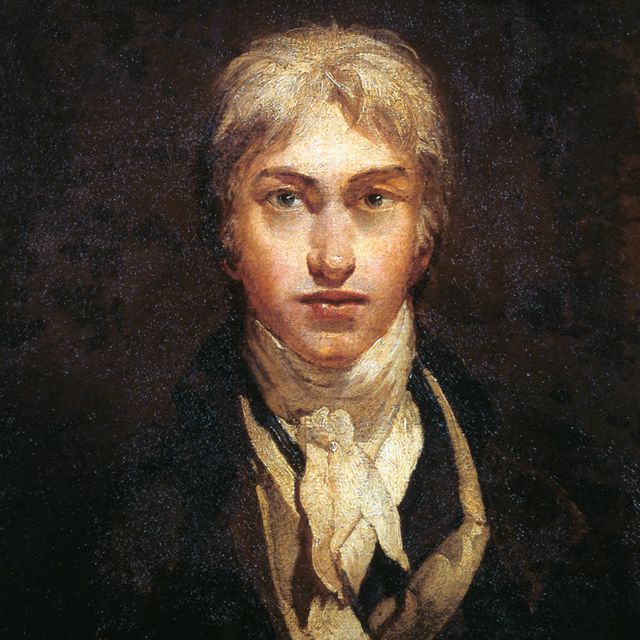(1775-1851)
Who Was J.M.W. Turner?
A sickly child, J.M.W. Turner was sent to live with his uncle in rural England, and it was during this period that he began his artistic career. As a landscape painter, Turner brought luminosity and Romantic imagery to his subjects. His work—initially realistic—became more fluid and poetic, and is now regarded as a predecessor to Impressionism.
Early Years
Joseph Mallord William Turner was born circa April 23, 1775, in Covent Garden, London, England. His father, a wig-maker and barber, supported the family through his wife’s struggles with mental illness, a condition worsened by the death of Turner’s younger sister in 1786.
Turner was sent to live with an uncle in nearby Brentford in 1785 but returned to Covent Garden by the end of the decade. Although he received little formal schooling, Turner was clearly a talented artist, and by age 13 he was selling drawings that were featured at his father's shop. The Royal Academy of Arts admitted Turner in late 1789, and the following year he was given the chance to display his work in the Royal Academy Exhibition.
Artistic Innovation and Success
In 1793, the Royal Society of Arts awarded the 17-year-old the “Great Silver Pallet” for landscape drawing. Turner soon earned a steady income through a variety of artistic endeavors, including selling designs to engravers, coloring sketches and providing private lessons. Among the artists who influenced his works during this period were Thomas Gainsborough, Henry Fuseli, Philippe Jacques de Loutherbourg, Michael Angelo Rooker and Richard Wilson.
Turner began traveling through Europe extensively and was particularly inspired by his visits to Venice. His initial efforts reflected his training as a topographic draftsman and resulted in realistic depictions of landscapes, but over the years he developed his own style. Known as the “Painter of Light,” he created scenes of luminous imagery using brilliant colors. His works -- watercolors, oil paintings and engravings -- are now regarded as a predecessor to Impressionism.
In 1807, Turner accepted a position as professor of perspective at the Royal Academy, where he lectured until 1828. He grew increasingly eccentric and secretive, avoiding contact with virtually everyone except for his father, and was embittered when Queen Victoria passed him over for knighthood. Turner continued to hold exhibitions but begrudgingly sold his paintings, the loss of each one catapulting him into a prolonged state of dejection.
Despite his unusual behavior, Turner continued to produce great works of art. Though he is best known for his oil paints, he is also considered one of the founders of English watercolor landscape painting. His famous works include Dido Building Carthage (1815), The Grand Canal, Venice (1835), Peace - Burial at Sea (1842) and Rain, Steam and Speed (1844).
Turner exhibited his works for the last time in 1850. He produced thousands of pieces over the course of his career; approximately 2,000 paintings became the property of private collectors, while another 19,000 drawings and sketches and nearly 300 finished and unfinished oil paintings were left behind at two studios
Personal Life and Death
Although Turner never married, he fathered two daughters, Eveline and Georgiana. Their mother was assumed to be Mrs. Sarah Danby, the widow of a London composer. However, many believed the children’s mother was actually Mrs. Danby’s niece, Hannah, who was employed by Turner as a housekeeper.
The artist died on December 19, 1851, in Cheyne Walk, Chelsea, London, England. His will allocated generous sums to Hannah Danby and to programs to support what he called "decaying artists," although relatives successfully contested the funding of those programs through litigation. Turner also bequeathed a large collection of paintings to his country, and at his request, he was buried in St. Paul's Cathedral in London.
QUICK FACTS
- Name: J.M.W. Turner
- Birth Year: 1775
- Birth date: April 23, 1775
- Birth City: London, England
- Birth Country: United Kingdom
- Gender: Male
- Best Known For: J.M.W. Turner was a British landscape painter of the 18th and 19th centuries whose work is known for its luminous, almost abstract quality.
- Industries
- Art
- Astrological Sign: Taurus
- Schools
- Royal Academy
- Death Year: 1851
- Death date: December 19, 1851
- Death City: London, England
- Death Country: United Kingdom
Fact Check
We strive for accuracy and fairness.If you see something that doesn't look right,contact us!
CITATION INFORMATION
- Article Title: J.M.W. Turner Biography
- Author: Biography.com Editors
- Website Name: The Biography.com website
- Url: https://www.biography.com/artists/jmw-turner
- Access Date:
- Publisher: A&E; Television Networks
- Last Updated: May 21, 2021
- Original Published Date: April 2, 2014












